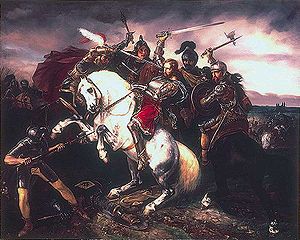Battle of Göllheim
| Battle of Göllheim | |||||||
|---|---|---|---|---|---|---|---|
| Part of the fight for the rule over the Holy Roman Empire | |||||||
 Death of Adolf of Nassau, Simon Meister, 1829 | |||||||
| |||||||
| Belligerents | |||||||
|
Duchy of Austria Kingdom of Bohemia |
County of Nassau Electoral Palatinate | ||||||
| Commanders and leaders | |||||||
| Albert I of Habsburg | Adolf of Nassau † | ||||||
Location within Germany | |||||||
The Battle of Göllheim was fought on 2 July 1298 between the forces of duke
Background
After the death of
Accordingly, at the next
As he was regarded as having repeatedly abused his royal prerogatives, the Electors deposed Adolf without any formal electoral process. As a result, Adolf chose to defend his rights as king, and went on campaign against the Habsburgs.[1][4]
Before this, and following a request of the Elector
Adolf approached from the imperial city of Worms, in order to relieve Alzey Castle. His forces consisted of contingents from the Taunus, Adolf's home region, the Electoral Palatinate, Franconia, Lower Bavaria, Alsace and St. Gallen.[2]
Battle

Albert initially avoided a collision, but then on July 2, 1298 deployed his troops in a strategically favorable position on the Hasenbühl, a hill near Göllheim. Göllheim community is located 20 km (12 mi) south of Alzey between Kaiserslautern and Worms, near the Donnersberg massif.[5]
The result of the battle was generally considered as a judgment of God. Nevertheless, Albert insisted on a formal election by the electors, which took place in Frankfurt on July 27, 1298. As the kingship returned to the Habsburgs, the conflicts of interest between the electors and the king continued.[1][2]
Adolf's widow, Imagina of Isenburg-Limburg, saw her husband's coffin transferred from Rosenthal Abbey to Speyer Cathedral by emperor Henry VII in 1309. There he was buried alongside his rival Albert, who had been murdered in 1308 by his own nephew Johann. Imagina had a memorial cross erected on the battlefield near Göllheim, which was designed in the early Gothic style. In the 19th century a chapel was built around it, and it has been preserved to this day.[3][7]
References
- ^ a b c Fred Weinmann. "Auf dem Hasenbühl verlor König Adolph Krone und Leben". Suehnekreuz. Retrieved 17 April 2020.
- ^ ISBN 978-3-406-50958-2.
- ^ a b c Fred Weinmann. "Adolf von Nassau". Deutsche Biographie. Retrieved 17 April 2020.
- ^ Andreas Marchetti. "DIE ABSETZUNG VON KÖNIG ADOLF VON NASSAU 1298" (PDF). Archive. Archived from the original (PDF) on 5 June 2011. Retrieved 17 April 2020.
- ISBN 978-1-60126-387-2.
- ^ Johannes ¬von Geissel (1835). Die Schlacht am Hasenbühl und das Königskreuz zu Göllheim: eine historische Monographie. Kranzbühler.
- ^ "Königskreuz". kreuzstein. Retrieved 17 April 2020.
- Wheatcroft, Andrew (1996) The Habsburgs, ISBN 0-14-023634-1

